The Potential Health Benefits of Reduced PM2.5 Exposure Through a More Rapid Green Transition of South Korea’s Transport Sector
Abstract
1. Introduction
2. Materials and Methods
3. Results
4. Discussion
5. Conclusions
Funding
Data Availability Statement
Conflicts of Interest
Abbreviations
| NDCs | Nationally Determined Contributions |
| CCUS | Carbon Capture, Utilization, and Storage |
| EVs | Electric Vehicles |
| UNFCC | United Nations Framework Convention on Climate Change |
| GHGs | Greenhouse Gases |
| MTCO2e | Million Tonnes of Carbon Dioxide Equivalent |
| PM2.5 | Particulate Matter that has a diameter of 2.5 μm or less |
| COPD | Chronic Obstructive Pulmonary Disease |
| ALRIs | Acute Lower Respiratory Infections |
| NO2 | Nitrogen Dioxide |
| SO2 | Sulfur Dioxide |
| NH3 | Ammonia |
References
- Dolge, K.; Barisa, A.; Kirsanovs, V.; Blumberga, D. The Status Quo of the EU Transport Sector: Cross-Country Indicator-Based Comparison and Policy Evaluation. Appl. Energy 2023, 334, 120700. [Google Scholar] [CrossRef]
- Park, M.; Wang, Z.; Li, L.; Wang, X. Multi-Objective Building Energy System Optimization Considering EV Infrastructure. Appl. Energy 2023, 332, 120504. [Google Scholar] [CrossRef]
- Singh, K.; Singh, A. Behavioural Modelling for Personal and Societal Benefits of V2G/V2H Integration on EV Adoption. Appl. Energy 2022, 319, 119265. [Google Scholar] [CrossRef]
- Chen, X.; Hu, X.; Liu, H. Low-Carbon Route Optimization Model for Multimodal Freight Transport Considering Value and Time Attributes. Socio-Econ. Plan. Sci. 2024, 96, 102108. [Google Scholar] [CrossRef]
- Pan, G.; Bai, Y.; Song, H.; Qu, Y.; Wang, Y.; Wang, X. Hydrogen Fuel Cell Power System—Development Perspectives for Hybrid Topologies. Energies 2023, 16, 2680. [Google Scholar] [CrossRef]
- Borowski, P.F.; Karlikowska, B. Clean Hydrogen Is a Challenge for Enterprises in the Era of Low-Emission and Zero-Emission Economy. Energies 2023, 16, 1171. [Google Scholar] [CrossRef]
- IEA. South Korea Energy Mix, 2023; International Energy Agency: Paris, France, 2024; Available online: https://www.iea.org/countries/korea/energy-mix (accessed on 25 January 2025).
- ROK. 2050 Carbon Neutral Strategy of the Republic of Korea: Towards a Sustainable and Green Society; Government Republic of Korea: Seoul, Republic of Korea, 2020. Available online: https://unfccc.int/documents/267683?gad_source=1&g (accessed on 25 January 2025).
- KEA. 2019 Total Energy Consumption and Greenhouse Gas Emissions Statistics; Korea Energy Agency (KEA): Ulsan, Republic of Korea, 2022; Available online: https://www.energy.or.kr/front/board/View9.do (accessed on 11 April 2025).
- Kim, H.; Kim, D.W.; Kim, M.K. Economics of Charging Infrastructure for Electric Vehicles in Korea. Energy Policy 2022, 164, 112875. [Google Scholar] [CrossRef]
- ROK. Summary of the Plan for Carbon-neutral Public Sector South Korea. Available online: https://www.sustainability.gov/pdfs/south-korea-nzgi-roadmap.pdf (accessed on 21 April 2025).
- Kim, Y.G.; Lim, H.; Lee, J. Decarbonizing Road Transport in Korea: Role of Electric Vehicle Transition Policies. Transp. Res. Part D Transp. Environ. 2024, 128, 104084. [Google Scholar] [CrossRef]
- Kim, Y.; Kim, J.; Cho, S.; Sim, H.; Kim, J.Y. Enhancing Environmental Policy Decisions in Korea and Japan Through AI-Driven Air Pollution Forecast. Sustainability 2024, 16, 10436. [Google Scholar] [CrossRef]
- Kim, N.R.; Lee, H.J. Ambient PM2.5 Exposure and Rapid Population Aging: A Double Threat to Public Health in the Republic of Korea. Environ. Res. 2024, 252, 119032. [Google Scholar] [CrossRef] [PubMed]
- EPA. Particulate Matter (PM) Pollution; United States Environmental Protection Agency: Washington, DC, USA, 2023. Available online: https://www.epa.gov/pm-pollution/particulate-matter-pm-basics (accessed on 18 May 2025).
- Ha, S.H.; Hwang, J.; Kim, N.; Lee, E.J.; Kim, B.J.; Kwon, S.U. Spatiotemporal Association between Air Pollution and Stroke Mortality in South Korea. J. Stroke Cerebrovasc. Dis. 2023, 32, 107348. [Google Scholar] [CrossRef] [PubMed]
- Burnett, R.T.; Arden Pope, C.; Ezzati, M.; Olives, C.; Lim, S.S.; Mehta, S.; Shin, H.H.; Singh, G.; Hubbell, B.; Brauer, M.; et al. An Integrated Risk Function for Estimating the Global Burden of Disease Attributable to Ambient Fine Particulate Matter Exposure. Environ. Health Perspect. 2014, 122, 397–403. [Google Scholar] [CrossRef]
- Han, C.; Kim, S.; Lim, Y.H.; Bae, H.J.; Hong, Y.C. Spatial and Temporal Trends of Number of Deaths Attributable to Ambient PM2.5 in the Korea. J. Korean Med. Sci. 2018, 33, e193. [Google Scholar] [CrossRef]
- HEI. The State of Global Air 2024; State of Global Air: Louisville, KY, USA, 2024. [Google Scholar]
- KoreaTimes. Korea Formally Becomes “Super-Aged” Society. 2024. Available online: https://www.koreatimes.co.kr/southkorea/society/20241224/korea-becomes-super-aged-society (accessed on 10 March 2025).
- UN. 2024 Revision of World Population Prospects; United Nations Department of Economic and Social Affairs: New York, NY, USA, 2024. [Google Scholar]
- WHO. Ambient Air Pollution: A Global Assessment of Exposure and Burden of Disease; World Health Organization: Geneva, Switzerland, 2016. [Google Scholar]
- Kim, M.S.; Lim, Y.H.; Oh, J.; Myung, J.; Han, C.; Bae, H.J.; Kim, S.; Hong, Y.C.; Lee, D.W. Long-Term Ozone Exposure, COPD, and Asthma Mortality: A Retrospective Cohort Study in the Republic of Korea. Atmosphere 2024, 15, 1340. [Google Scholar] [CrossRef]
- Jin, S.H. Are South Korea’s Environmental Policies Rational? An Analysis Focusing on Fine Dust Programs in the Seoul Metropolitan Area. Sustainability 2024, 16, 6293. [Google Scholar] [CrossRef]
- Ho, C.H.; Kim, K.Y. Ineffective Implementation of Emergency Reduction Measures against High Concentrations of Particulate Matter in Seoul, Republic of Korea. Environ. Monit. Assess. 2023, 195, 1127. [Google Scholar] [CrossRef]
- Park, J.; Park, S. Estimating Regional CO2 and NOx Emissions from Road Transport Using Real-World Data-Based Emission Factors in Korea. Environ. Pollut. 2024, 352, 124140. [Google Scholar] [CrossRef] [PubMed]
- Stockholm Environment Institute (SEI). Low Emissions Analysis Platform-Integrated Benefits Calculator (LEAP-IBC) Key Features in LEAP-IBC; Stockholm Environment Institute: Stockholm, Sweden, 2017; Available online: https://www.sei.org/publications/leap-Ib (accessed on 12 May 2025).
- ROK. South Korea Government 2050 Carbon Neutrality Scenarios; Office for Government Policy Coordination, Government Republic of Korea: Seoul, Republic of Korea, 2024. Available online: http://webarchives.pa.go.kr/19th/www.2050cnc.go.kr/eng/contents/view?contentsNo=42&menuLevel=2&menuNo=49 (accessed on 11 March 2025).
- IIASA. IIASA ECLIPSE V5a Global Emission Fields; IIASA: Laxenburg, Austria, 2025; Available online: https://iiasa.ac.at/web/home/research/researchprograms/air/ECLIPSEv5a.html (accessed on 15 April 2025).
- Henze, D.K.; Hakami, A.; Seinfeld, J.H. Development of the Adjoint of GEOS-Chem. Atmos. Chem. Phys. 2007, 7, 2413–2433. [Google Scholar] [CrossRef]
- Kuylenstierna, J.C.I.; Heaps, C.G.; Ahmed, T.; Vallack, H.W.; Hicks, W.K.; Ashmore, M.R.; Malley, C.S.; Wang, G.; Lefèvre, E.N.; Anenberg, S.C.; et al. Development of the Low Emissions Analysis Platform—Integrated Benefits Calculator (LEAP-IBC) Tool to Assess Air Quality and Climate Co-Benefits: Application for Bangladesh. Environ. Int. 2020, 145, 106155. [Google Scholar] [CrossRef]
- Jao, J.; Toyokan, M.; Vallar, E.; Silva, L.; Galvez, M.C. Assessment of Municipal Solid Waste Management Scenarios in Metro Manila Using the Long-Range Energy Alternatives Planning-Integrated Benefit Calculator (LEAP-IBC) System. Sustainability 2024, 16, 6246. [Google Scholar] [CrossRef]
- Nakarmi, A.M.; Sharma, B.; Rajbhandari, U.S.; Prajapati, A.; Malley, C.S.; Kuylenstierna, J.C.I.; Vallack, H.W.; Henze, D.K.; Panday, A. Mitigating the Impacts of Air Pollutants in Nepal and Climate Co-Benefits: A Scenario-Based Approach. Air Qual. Atmos. Health 2020, 13, 361–370. [Google Scholar] [CrossRef]
- Kim, S.H.; Lee, S.J.; Han, S.Y.; Kim, J.H. Scenario Analysis for GHG Emission Reduction Potential of the Building Sector for New City in South Korea. Energies 2020, 13, 5514. [Google Scholar] [CrossRef]
- Lee, S.; Park, J.W.; Song, H.J.; Maken, S.; Filburn, T. Implication of CO2 Capture Technologies Options in Electricity Generation in Korea. Energy Policy 2008, 36, 326–334. [Google Scholar] [CrossRef]
- Hong, J.H.; Kim, J.; Son, W.; Shin, H.; Kim, N.; Lee, W.K.; Kim, J. Long-Term Energy Strategy Scenarios for South Korea: Transition to a Sustainable Energy System. Energy Policy 2019, 127, 425–437. [Google Scholar] [CrossRef]
- Phillips, D.; Jung, T.Y. An Alternative Co-Benefit Framework Prioritizing Health Impacts: Potential Air Pollution and Climate Change Mitigation Pathways through Energy Sector Fuel Substitution in South Korea. Climate 2021, 9, 101. [Google Scholar] [CrossRef]
- KOSIS. Korean Statistical Information Service (KOSIS). Deaths and Death Rates by Cause (236 Item), Sex, and Age (by Five-Year Age Group); Korean Statistical Information Service (KOSIS): Daejeon, Korea, 2024; Available online: https://kosis.kr/eng/ (accessed on 1 May 2025).
- Shin & Kim. Korean 11th Basic Plan for Supply and Demand of Power (English); Ministry of Trade, Industry & Energy, Republic of Korea: Sejong-si, Republic of Korea, 2024. Available online: https://www.shinkim.com/eng/media/newsletter/2480 (accessed on 16 March 2025).
- Jung, J.; Yeo, S.; Lee, Y.; Moon, S.; Lee, D.J. Factors Affecting Consumers’ Preferences for Electric Vehicle: A Korean Case. Res. Transp. Bus. Manag. 2021, 41, 100666. [Google Scholar] [CrossRef]
- Park, K.; Jang, D.; Kim, S.; Lim, Y.; Lee, J. A Grid-Friendly Electric Vehicle Infrastructure: The Korean Approach. IEEE Power Energy Mag. 2023, 21, 28–37. [Google Scholar] [CrossRef]
- Lee, E.; Mah, J.S. Environmental Protection and Development of Technology-Intensive Industries: The Case of New Energy Vehicle Industry in Korea. Sci. Technol. Soc. 2021, 26, 413–432. [Google Scholar] [CrossRef]
- Hwang, H.; Lee, Y.; Seo, I.; Chung, Y. Successful Pathway for Locally Driven Fuel Cell Electric Vehicle Adoption: Early Evidence from South Korea. Int. J. Hydrog. Energy 2021, 46, 21764–21776. [Google Scholar] [CrossRef]
- Fan, T.; Chapman, A. Policy Driven Compact Cities: Toward Clarifying the Effect of Compact Cities on Carbon Emissions. Sustainability 2022, 14, 12634. [Google Scholar] [CrossRef]
- Park, J.; Jung, S. Exploring Urban Compactness and Greenhouse Gas Emissions in the Road Transport Sector: A Case Study of Big Cities in South Korea. Sustainability 2024, 16, 1911. [Google Scholar] [CrossRef]
- Jung, J.B.; Lim, M.G.; Kim, J.Y.; Han, B.G.; Kim, B.K.; Rho, D.S. Safety Assessment for External Short Circuit of Li-Ion Battery in ESS Application Based on Operation and Environment Factors. Energies 2022, 15, 5052. [Google Scholar] [CrossRef]
- KoreaTimes. EV-Caused Fire in Incheon Raises Concerns About Lithium-Ion Batteries. 2024. Available online: https://www.koreatimes.co.kr/www/nation/2024/12/113_37 (accessed on 20 April 2025).
- TheChosunDaily. South Korea Grapples with EV Phobia. 2024. Available online: https://www.chosun.com/english/national-en/2024/08 (accessed on 12 May 2025).
- KoreaTimes. Explosion of Hydrogen Vehicle Raises Safety Worries. 2024. Available online: https://www.koreatimes.co.kr/southkorea/society/20241225/explosion-of-hydrogen-vehicle-in-south-korea-raises-safety-worries (accessed on 11 February 2025).
- Zhang, Y.; Yu, Y.; Zou, B. Analyzing Public Awareness and Acceptance of Alternative Fuel Vehicles in China: The Case of EV. Energy Policy 2011, 39, 7015–7024. [Google Scholar] [CrossRef]
- Lim, S.; Dolsak, N.; Prakash, A.; Tanaka, S. Distributional Concerns and Public Opinion: EV Subsidies in the U.S. and Japan. Energy Policy 2022, 164, 112883. [Google Scholar] [CrossRef]
- Busch, P.; Pares, F.; Chandra, M.; Kendall, A.; Tal, G. Future of Global Electric Vehicle Supply Chain: Exploring the Impact of Global Trade on Electric Vehicle Production and Battery Requirements. Transp. Res. Rec. 2024, 2678, 1468–1482. [Google Scholar] [CrossRef]
- Miao, Y.; Liu, L.; Zhang, Y.; Tan, Q.; Li, J. An Overview of Global Power Lithium-Ion Batteries and Associated Critical Metal Recycling. J. Hazard. Mater. 2022, 425, 127900. [Google Scholar] [CrossRef]
- Abbas, Z.; Fatima, K.; Naz, A.; Parveen, A.; Shaikh, S.F. New Stable Rare Earth Ti-Based Semiconductor Pyrochlore Oxides for Low-Cost Energy Applications. J. Mater. Sci. 2024, 59, 19558–19583. [Google Scholar] [CrossRef]
- Choi, H.; Lim, N.G.; Lee, S.J.; Park, J. Feasibility Study for Sustainable Use of Lithium-Ion Batteries Considering Different Positive Electrode Active Materials under Various Driving Cycles by Using Cell to Electric Vehicle (EV) Simulation. Sustainability 2020, 12, 9764. [Google Scholar] [CrossRef]
- Ma, Z.; Zhao, C.; Woo, S.; Wang, C. Unlocking the Potential of Urban EV Battery Recycling: A Dual Optimization Model. J. Environ. Manag. 2024, 372, 123301. [Google Scholar] [CrossRef]
- Lee, Y.; Kim, M.; Kim, K. Revisiting Actors’ Role in Circular Economy Governance: A Case of Electric Vehicle Waste Batteries in South Korea. Environ. Eng. Res. 2024, 29, 230351. [Google Scholar] [CrossRef]
- Han, H.; Lee, T. Varieties of Green Stimulus Policies: Comparative Analysis of the Green Growth and Green New Deal Policies in South Korea. J. Environ. Dev. 2023, 32, 61–82. [Google Scholar] [CrossRef]
- Ghorbal, S.; Ben Youssef, S. Scrutinizing the Role of Renewable Energy and Patents in Pollution Abatement and Economic Growth in South Korea. Energy Environ. 2024, 35, 3232–3252. [Google Scholar] [CrossRef]
- Kim, D.; Choi, H.E.; Gal, W.M.; Seo, S. Five Year Trends of Particulate Matter Concentrations in Korean Regions (2015–2019): When to Ventilate? Int. J. Environ. Res. Public Health 2020, 17, 5764. [Google Scholar] [CrossRef]
- Eum, J.; Kim, H. Effects of Air Pollution on Assaults: Findings from South Korea. Sustainability 2021, 13, 11545. [Google Scholar] [CrossRef]
- Lu, J.; Lee, Y. Spatial Effects of Air Pollution on the Housing Market: Evidence from South Korea. J. Real Estate Res. 2022, 44, 131–150. [Google Scholar] [CrossRef]
- Kim, M.J. Air Pollution, Health, and Avoidance Behavior: Evidence from South Korea. Environ. Resour. Econ. 2021, 79, 63–91. [Google Scholar] [CrossRef]
- Han, A.; Kim, T.; Ten, G.K.; Wang, S. Air Pollution and Gender Imbalance in Labor Supply Responses: Evidence from South Korea. Econ. Model. 2023, 124, 106290. [Google Scholar] [CrossRef]
- Sekhon, D.; Alcala, E.; Kwon, J.; Bush, J.; Garza, M.A. Association Between Particulate Matter 2.5 and Breast Cancer Mortality in California—A Place-Based Cross-Sectional Study. Pollutants 2025, 5, 11. [Google Scholar] [CrossRef]
- Shim, C.; Han, J.; Henze, D.K.; Shephard, M.W.; Zhu, L.; Moon, N.; Kharol, S.K.; Dammers, E.; Cady-Pereira, K. Impact of NH3 Emissions on Particulate Matter Pollution in South Korea: A Case Study of the Seoul Metropolitan Area. Atmosphere 2022, 13, 1227. [Google Scholar] [CrossRef]
- Kim, D.; Kim, H.; Hwang, M.; Lee, Y.; Min, C.; Yoon, S.; Seo, S. Enhancing Particulate Matter Estimation in Livestock-Farming Areas with a Spatiotemporal Deep Learning Model. Atmosphere 2024, 16, 12. [Google Scholar] [CrossRef]
- Choi, J.; Park, R.J.; Lee, H.M.; Lee, S.; Jo, D.S.; Jeong, J.I.; Henze, D.K.; Woo, J.H.; Ban, S.J.; Lee, M.; et al. Impacts of Local vs. Trans-Boundary Emissions from Different Sectors on PM2.5 Exposure in South Korea during the KORUS-AQ Campaign. Atmos. Environ. 2019, 203, 196–205. [Google Scholar] [CrossRef]
- Kumar, N.; Park, R.J.; Jeong, J.I.; Woo, J.H.; Kim, Y.; Johnson, J.; Yarwood, G.; Kang, S.; Chun, S.; Knipping, E. Contributions of International Sources to PM2.5 in South Korea. Atmos. Environ. 2021, 261, 118542. [Google Scholar] [CrossRef]
- Cheol Kim, H.; Kim, E.; Bae, C.; Hoon Cho, J.; Kim, B.U.; Kim, S. Regional Contributions to Particulate Matter Concentration in the Seoul Metropolitan Area, South Korea: Seasonal Variation and Sensitivity to Meteorology and Emissions Inventory. Atmos. Chem. Phys. 2017, 17, 10315–10332. [Google Scholar] [CrossRef]
- Bae, M.; Kim, B.U.; Kim, H.C.; Kim, S. A Multiscale Tiered Approach to Quantify Contributions: A Case Study of PM2.5 in South Korea during 2010–2017. Atmosphere 2020, 11, 141. [Google Scholar] [CrossRef]
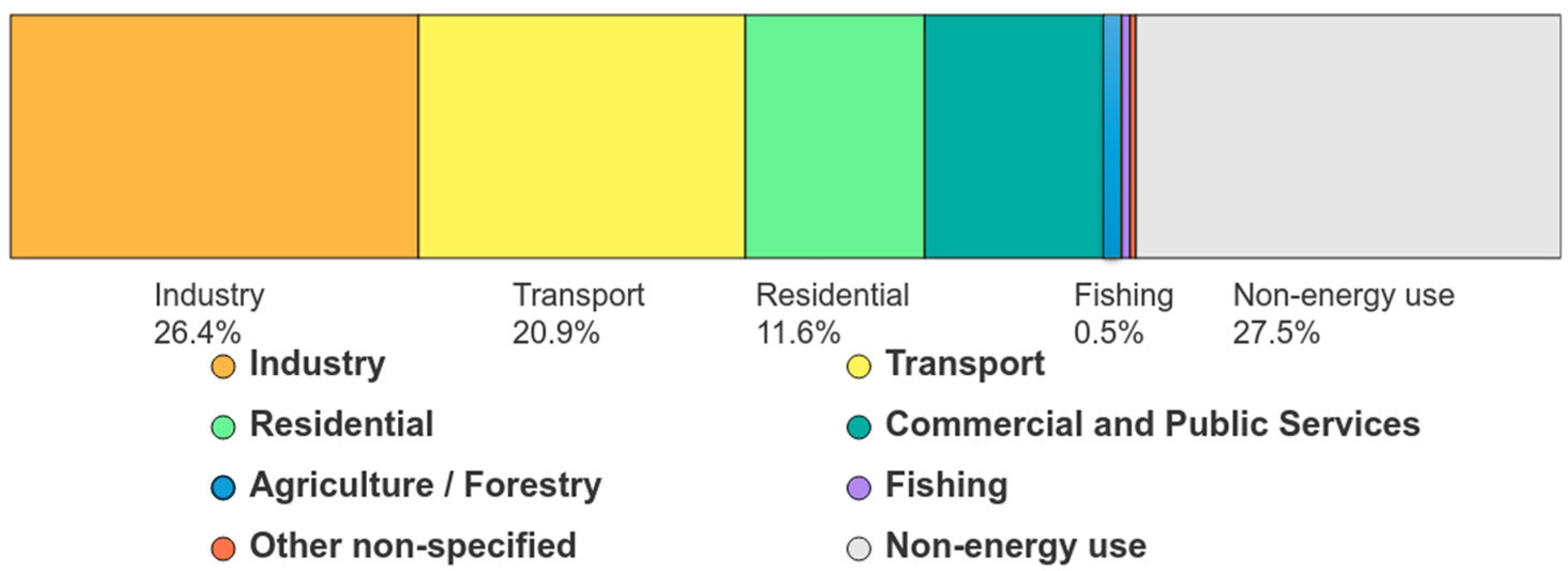
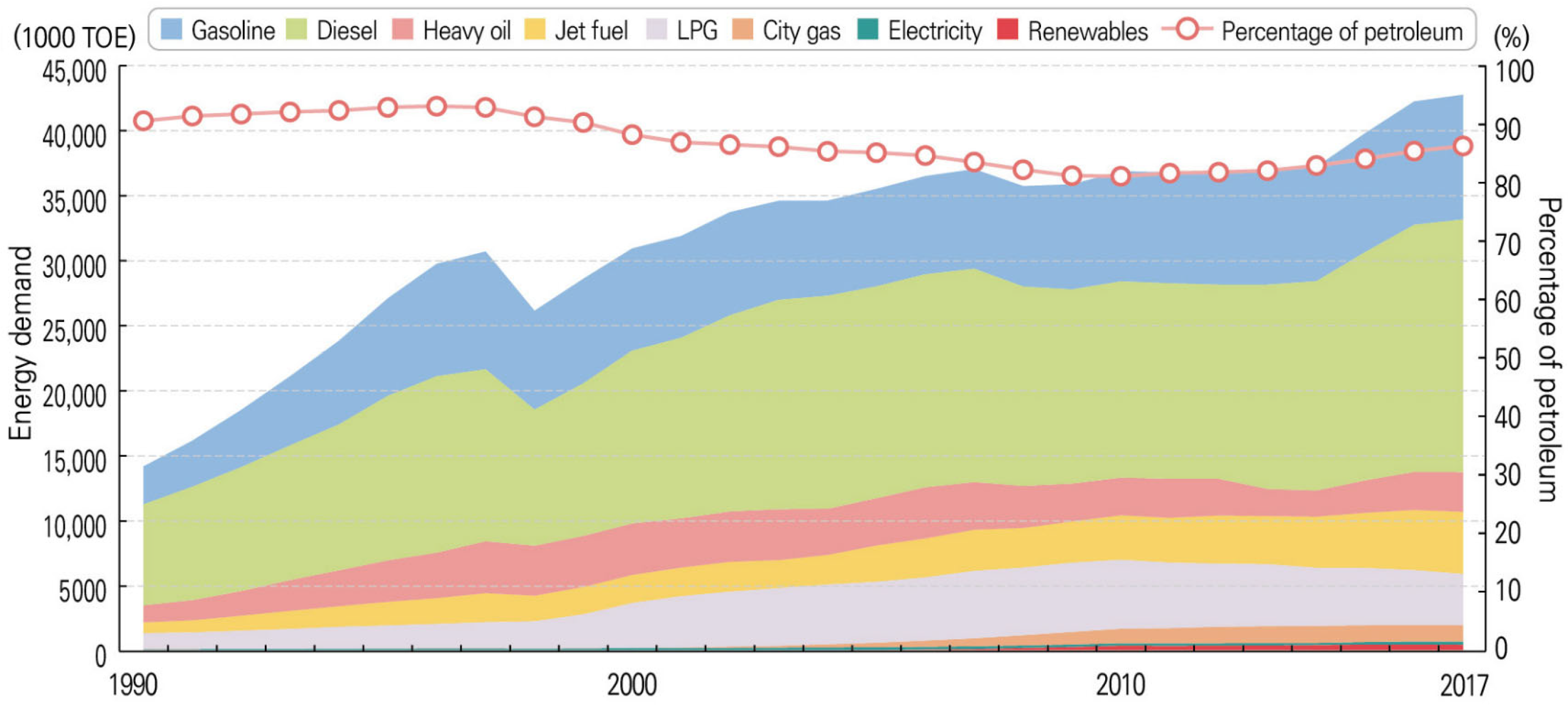
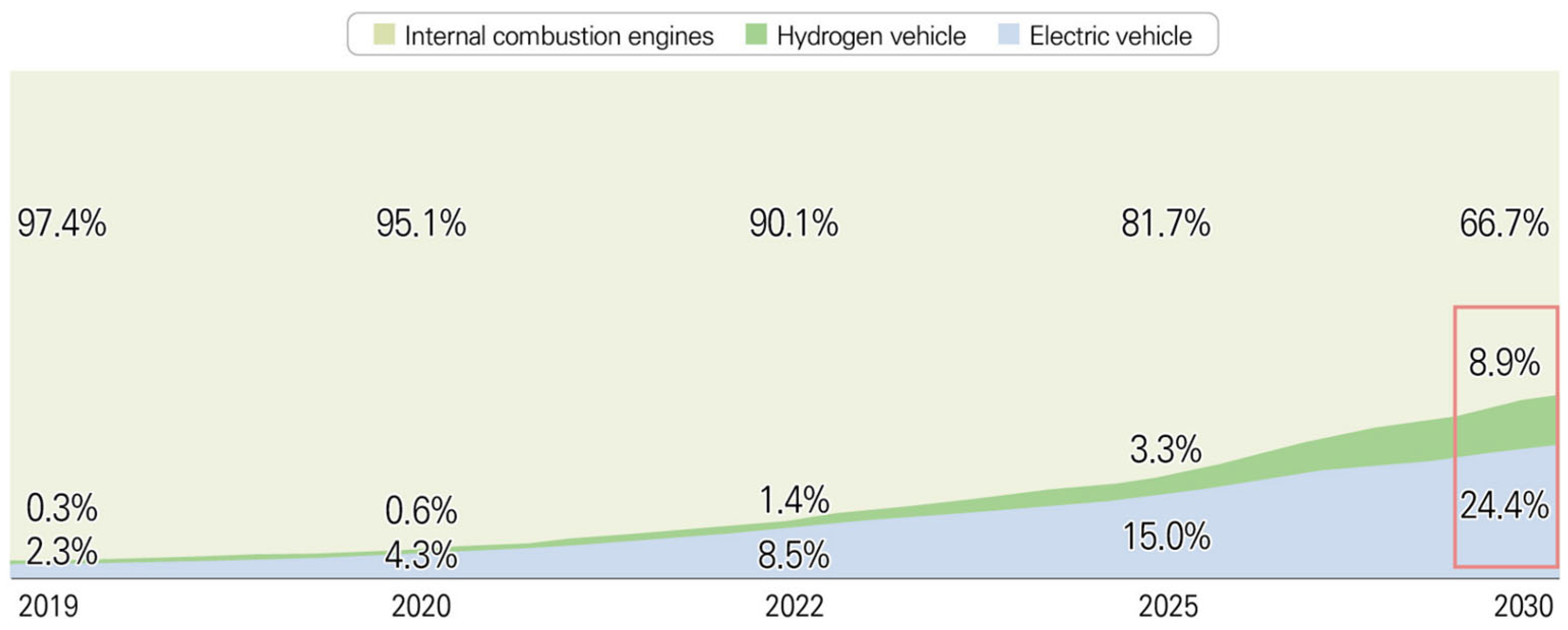
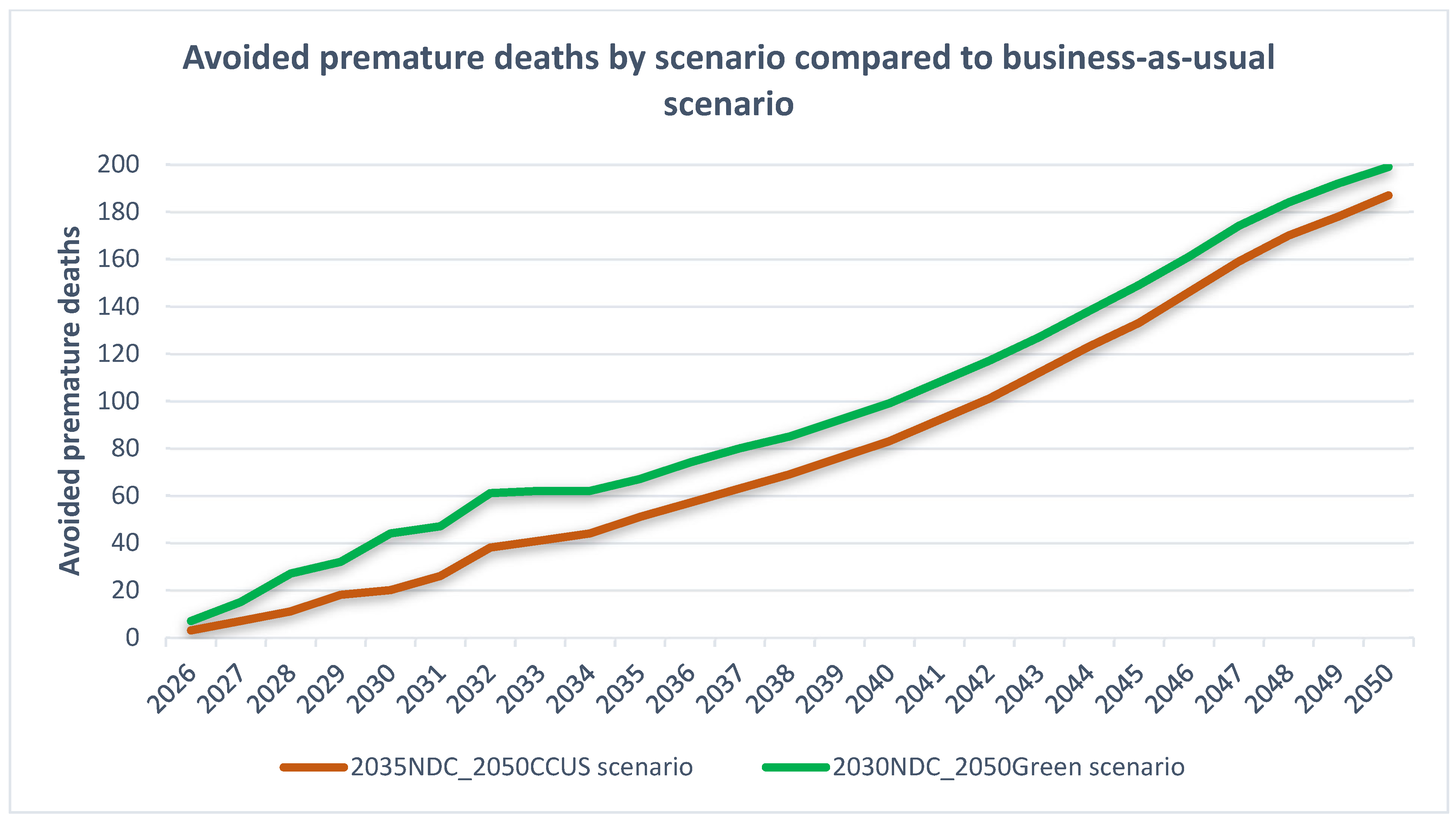
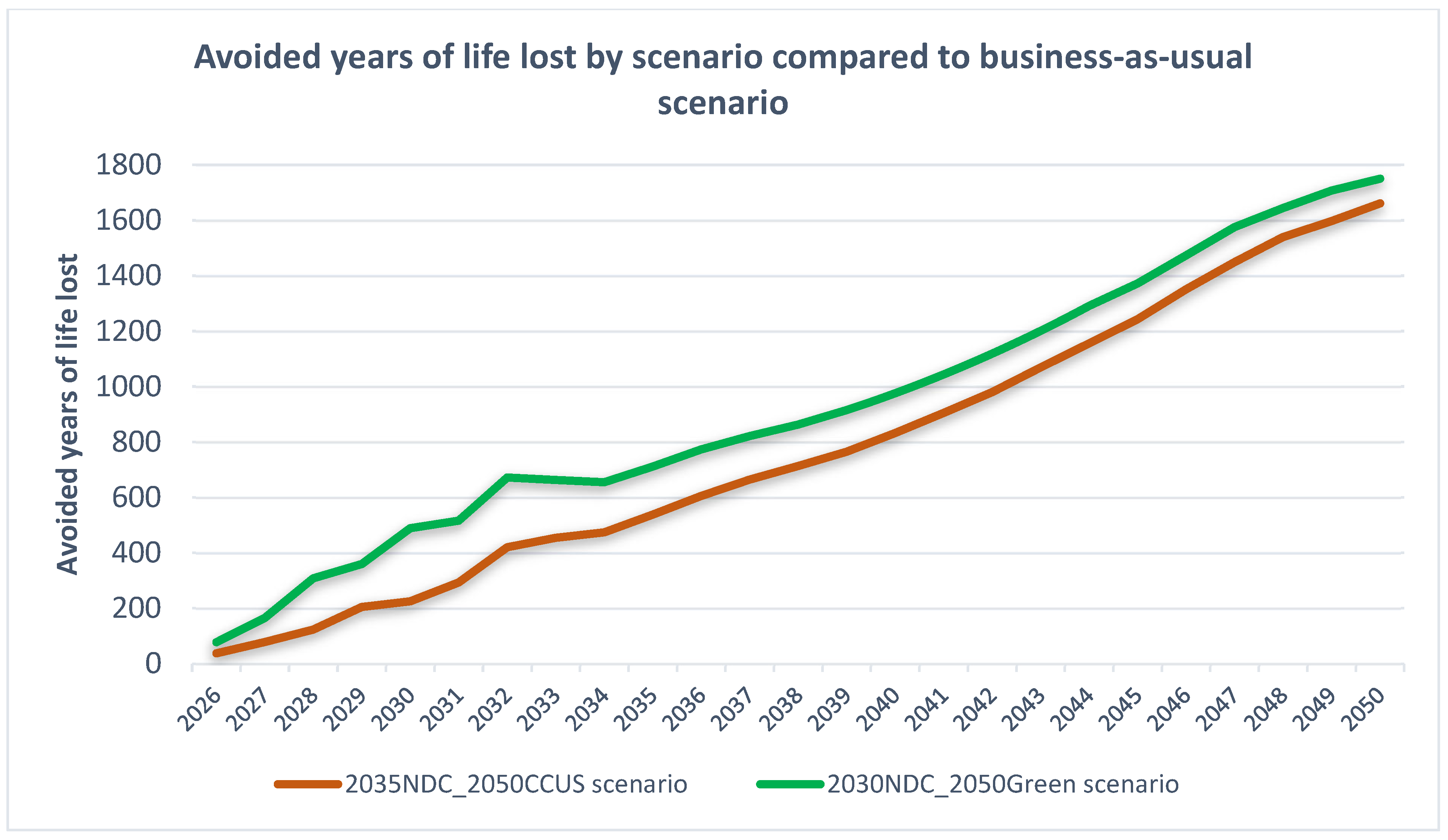
| Pollutant | Averaging Time | Air Quality Guideline |
|---|---|---|
| PM2.5 µg m−3 | Annual | 5 |
| PM2.5 µg m−3 | 24 h | 15 |
| PM10 µg m−3 | Annual | 15 |
| PM10 µg m−3 | 24 h | 45 |
| Category | Sector | 2018 | 2050 Scenario A | 2050 Scenario B | Note |
|---|---|---|---|---|---|
| Emissions | Energy | 269.6 | 0 | 20.7 | Scenario A: Complete green transition of power generation. Scenario B: Some power generated using liquefied natural gas (LNG). |
| Industry | 260.5 | 51.1 | 51.1 | ||
| Buildings | 52.1 | 6.2 | 6.2 | ||
| Transport | 98.1 | 2.8 | 9.2 | Scenario A: Complete transition to electric vehicles and hydrogen vehicles. Scenario B: Some alternative fuels such as e-fuels and biofuels utilized. | |
| Agriculture | 24.7 | 15.4 | 15.4 | ||
| Waste | 17.1 | 4.4 | 4.4 | ||
| Hydrogen | - | 0 | 9 | ||
| Omissions | 5.6 | 0.5 | 13 | ||
| Absorption and Removal | Carbon Sinks | −41.3 | −25.3 | −25.3 | |
| Carbon Capture, Use, and Storage (CCUS) | - | −55.1 | −84.6 | ||
| Direct Air Capture (DAC) | - | - | −7.4 | ||
| Total net emissions | 686.3 | 0 | 0 | ||
| Scenario Name | Description |
|---|---|
| Business-as-usual | Transport sector emissions follow the current trajectory of slow rate of electric and hydrogen vehicle adoption. For other sectors, targets of 2050 carbon neutrality scenario B are met. |
| 2035NDC_2050 CCUS | Transport sector emissions are reduced to meet 2030 NDC target in 2035. The 2050 transport emissions are according to 2050 carbon neutrality scenario B which relies on CCUS to offset remaining transport sector emissions. |
| 2030NDC_2050 Green | Transport sector emissions are rapidly reduced through replacement of gasoline and diesel vehicles with electric and hydrogen vehicles to meet 2030 NDC in 2030. The 2050 carbon neutrality of the transport sector is achieved through complete green transition into electric vehicles and hydrogen vehicles, meeting the South Korean government’s 2050 carbon neutrality scenario A for the transport sector emission reduction target. |
| 2026–2030 Average | 2026–2035 Average | 2036–2050 Average | Total Avoided Emissions | |
|---|---|---|---|---|
| 2035NDC_2050CCUS scenario | 4.5 | 4.6 | 3.5 | 1335.9 |
| 2030NDC_2050Green scenario | 8.9 | 5.9 | 2.9 | 1644.0 |
| Total Avoided Premature Deaths | Total Avoided Years of Life Lost | Total Avoided GHGs | |
|---|---|---|---|
| 2035NDC_2050CCUS scenario | 2008 | 19,377 | 1335.9 |
| 2030NDC_2050Green scenario | 2403 | 23,139 | 1644.0 |
Disclaimer/Publisher’s Note: The statements, opinions and data contained in all publications are solely those of the individual author(s) and contributor(s) and not of MDPI and/or the editor(s). MDPI and/or the editor(s) disclaim responsibility for any injury to people or property resulting from any ideas, methods, instructions or products referred to in the content. |
© 2025 by the author. Licensee MDPI, Basel, Switzerland. This article is an open access article distributed under the terms and conditions of the Creative Commons Attribution (CC BY) license (https://creativecommons.org/licenses/by/4.0/).
Share and Cite
Phillips, D. The Potential Health Benefits of Reduced PM2.5 Exposure Through a More Rapid Green Transition of South Korea’s Transport Sector. Pollutants 2025, 5, 35. https://doi.org/10.3390/pollutants5040035
Phillips D. The Potential Health Benefits of Reduced PM2.5 Exposure Through a More Rapid Green Transition of South Korea’s Transport Sector. Pollutants. 2025; 5(4):35. https://doi.org/10.3390/pollutants5040035
Chicago/Turabian StylePhillips, Dafydd. 2025. "The Potential Health Benefits of Reduced PM2.5 Exposure Through a More Rapid Green Transition of South Korea’s Transport Sector" Pollutants 5, no. 4: 35. https://doi.org/10.3390/pollutants5040035
APA StylePhillips, D. (2025). The Potential Health Benefits of Reduced PM2.5 Exposure Through a More Rapid Green Transition of South Korea’s Transport Sector. Pollutants, 5(4), 35. https://doi.org/10.3390/pollutants5040035






